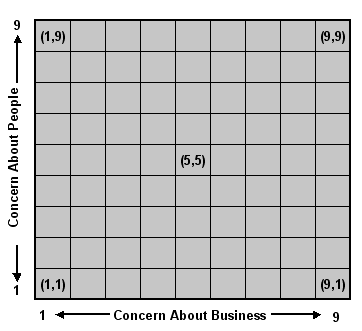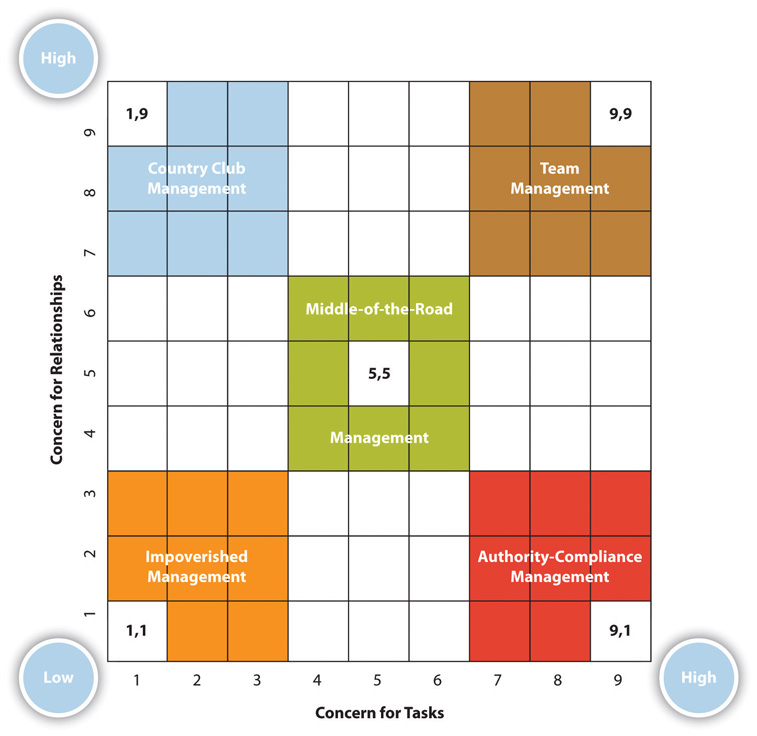- Home
- Business Processes
- Industry Knowledge
- Aerospace Industry
- Automotive Industry
- Banking Domain
- BFSI Industry
- Consumer/ FMCG Industry
- Chemicals Industry
- Engineering & Construction
- Energy Industry
- Education Domain
- Finance Domain
- Hospitality Domain
- Healthcare Industry
- Insurance Domain
- Retail Industry
- Travel and Tourism Domain
- Telecom Industry
- Leadership Skills
- eLearning
- Home
- Leadership
- Leadership Theories
- Managerial Grid Theory
Managerial Grid Theory
Blake and Mouton Managerial Grid is a style leadership model that identified five manager styles based on two dimensions viz concern for people and the concern for production. Managerial Grid uses concern for production style which is largely based on McGregor's Theory X.
 Do you know whether you are task oriented or person oriented? What is your leadership style in a given situation? Learn about the task v/s people orientation and understand “The Blake Mouton Managerial Grid” in this article and explore how you can apply these principles in your day to day leadership journey.
Do you know whether you are task oriented or person oriented? What is your leadership style in a given situation? Learn about the task v/s people orientation and understand “The Blake Mouton Managerial Grid” in this article and explore how you can apply these principles in your day to day leadership journey.
Managerial Styles:
Later work on leadership theory by R. R. Blake and J. S. Mouton used task versus people orientation to chart a person’s leadership “style.” The result is what researchers call the Managerial or Leadership Grid. (See figure for managerial grid). Blake and Mouton, in their managerial grid model, proposed five leadership styles based on two axes – concern for the task versus concern for people. They suggested that the ideal is the "team style", which balances concern for the task with concern for people. Different patterns of behavior were grouped together and labeled as styles. This became a very popular activity within management training, various schemes appeared, designed to diagnose and develop people’s style of working.
What is Task V/s People Orientation?
We as a person are either very task oriented or very person oriented and same is true for leaders. Some leaders are very task-oriented and their immediate focus is to simply get the things done and on the other hand some leaders are very people-oriented and they strive to make people happy. Some could be combination of the two. If as a leader you prefer to lead by setting and enforcing task level timelines and keeping a close follow-up on remaining tasks, you tend to be more production/task-oriented whereas on the other hand if you make people your priority and generally try to accommodate employee needs before tasks, then you’re more people-oriented. There is nothing right or wrong in being on the either side of this preference. Leaders can be oriented towards both tasks and persons. This is one of the tools that is very helpful for you to understand your natural leadership tendencies.
The Blake Mouton Managerial Grid:
This theory by Blake and Mouton (1978) has a popular application of both task and person orientation. According to this theory leaders are most effective when they achieve a high and balanced concern for people and for tasks.
Understanding the Framework:
The Managerial Grid is based on two behavioral dimensions:
1. Concern for People: This is the degree to which a leader considers the needs of team members, their interests, and areas of personal development when deciding how best to accomplish a task. In this style, leaders look upon their followers as people - their needs, interests, problems, development and so on. They are not simply units of production or means to an end.
2. Concern for Production: This is the degree to which a leader emphasizes organizational efficiency and high productivity when deciding how best to accomplish a task. Here leaders emphasize the achievement of concrete objectives. They look for high levels of productivity, and ways to organize people and activities in order to meet those objectives.
The Methodology:
The grid shown below depicts two dimensions of leader behavior, concern for people on y-axis and concern for production on x-axis, with each dimension ranging from low (1) to high (9), thus creating 81 different positions in which the leader’s style may fall. This framework plots the degree of task-centeredness versus person-centeredness. Each leader can be rated somewhere along each of the axes from 1 to 9 depending on his orientation and the axis is used to plot leadership ‘concerns for production’ versus ‘concerns for people’. Although there can be 81 possible combinations you should try to understand the 5 types that identifies distinct leadership styles (Marked in the figure). These will give you a basic understanding of the theory, on which you can base your other combinations.
|
1,9 |
|
|
|
|
|
|
|
9,9 |
|
|
|
|
|
|
|
|
|
|
|
|
|
|
|
|
|
|
|
|
|
|
|
|
|
|
|
|
|
|
|
|
|
|
|
5,5 |
|
|
|
|
|
|
|
|
|
|
|
|
|
|
|
|
|
|
|
|
|
|
|
|
|
|
|
|
|
|
|
|
|
|
|
1,1 |
|
|
|
|
|
|
|
9,1 |
Blake and Mouton defined the following five leadership styles:
1. Country Club Leadership:
The (1, 9) leader is primarily concerned for people and only incidentally concerned with production. The leader's major responsibility is to establish harmonious relationships among subordinates and to provide a secure and pleasant work atmosphere. He is called as Country Club Management leader. In this management style we have high people satisfaction and low production levels. This style of leader is most concerned about the needs and feelings of members of the team operating under the assumption that as long as subordinates are happy and feel good, they will work hard. These managers exhibit a high concern for people and building a friendly environment. They have a lower concern with the task and with getting things done. The outcome of such a management style is a very relaxed and open environment but the delivery or production suffers due to lack of direction and control.
2. Produce or Perish Leadership:
The (9, 1) leader is primarily concerned about the task or production. Managers in this category believe that employees are simply a means to an end and employee needs are secondary to the need for efficient and productive workplaces. He is concerned with his responsibility to see that the work is completed. He is also called a Task-Management leader or the style is also referred to as “Authority - Compliance Management Style”. These managers have a high concern for task and emphasize productivity and efficiency at all times. These managers are also known as authoritarian or Compliance Leaders, This approach results in high production but low people satisfaction levels. This type of leader is very autocratic, has strict work rules, and always insists on policies, and procedures, and use punishment as the most effective means to motivate employees.
3. Impoverished Leadership:
The (1,1) leader is concerned with neither production nor people. He tries to stay out of the way and not become involved in the conflict between the necessity for production and the attainment of good working relationship. He is called as Impoverish Management leader. This management style generally results in low Production and low people satisfaction levels. These managers take a lazy approach to leadership and hence the manager is mostly ineffective, as he has neither a high regard for getting job done, nor for creating a satisfying work environment. They have little regard for people or task and are very poor managers and hence the result is a place of failures, disorganization, dissatisfaction and disharmony.
4. Middle-of-the-Road Leadership:
The (5,5) leader reflects a middle ground position and is called as Middle of the Road Management leader. He seeks to compromise between high production and employee satisfaction. The result is generally medium production and medium people satisfaction. This style seems to be a balance of the two competing concerns or we can assume that these leaders have minimal focus on people and task. It may at first appear to be an ideal compromise but what it results is in preserving the status quo. Leaders who use this style settle for average performance, generally do what must be done, but do not set high standards or raise the bar for performance.
5. Team Leadership:
The (9,9) leader is extremely concerned about the task and also the people. He is concerned to see that the work accomplishment is from committed people; interdependence through a common stake in the organization; purpose leads to relationship of trust and respect. He is called a Team Management leader. This style leads to higher production levels as well as higher people satisfaction levels. This is the pinnacle of managerial style as these leaders accomplish production needs and stress the needs of the people equally highly. These leaders are the most effective managers. They are highly focused both on people and task and they maintain high performance standards. The leader feels that empowerment, commitment, trust, and respect are the key elements in creating a team atmosphere which will automatically result in high employee satisfaction and production. This style brings employees commitment and bridges the gap between organizational needs and employee perceived needs. This builds a team environment based on trust and respect, which leads to high satisfaction and motivation and, as a result, high production.
Practical Applications of Blake Mouton Managerial Grid:
The Managerial or Leadership Grid is used to help managers analyze their own leadership styles through a technique known as grid training. This is done by administering a questionnaire that helps managers identify how they stand with respect to their concern for production and people. The training is aimed at basically helping leaders reach to the ideal state of 9, 9. It is important to understand how you currently operate, so that you can then identify ways of becoming competent in both realms.
You can use the following approach to practically use this tool in your day to day life:
Step One: Identify your leadership style
Step Two: Identify the leadership style of your subordinates and stakeholder
Step Three: Identify areas of improvement and develop your leadership skills
Step Four: Analyze your current leadership method and critically analyze its effectiveness.
Step Five: Learn to flex your style to shift from one management style to other based on situation or the person involved
Step Six: Test the effectiveness of the style flexing and find the most effective approach for distinct situations and stakeholders.
Advantages of Managerial Grid:
This theory of leadership styles led to research on leaders’ use of power versus influence to accomplish tasks and obtain results. This and similar models give you several lenses through which to view leadership. While there does not exist a universal approach or set of traits that defines a good leader, you can adopt a specific approach or management style to influence or direct your subordinates, depending on the situation you face.
Limitations / Criticisms:
Scouller (2011) argued that this ideal approach may not suit all circumstances; for example, emergencies or turnarounds. This model ignores the importance of internal and external limits, matter and scenario. Also, there are some more aspects of leadership that can be covered but are not. The grid does not entirely address the complexity of “Which leadership style is best?”

Related Links
You May Also Like
-
The Systemic Approach to Leadership
The systemic approach to leadership looks at the organization as a whole and focuses on the understanding of the organization as a system. Moving to systems thinking demand managers to view organizations as organic systems. Leaders are also part of this complex system which is constantly undergoing change and evolving. The leaders need to manage the relations and networks within these systems by acting with systemic awareness.
-
The multiple linkage model states that leadership effectiveness is based on six variables. Multiple variables of a leader's behavior and situation have a linkage to the performance of the individual follower and work unit performance. The theory is based on the notion of the link between the organization process and managerial influence.
-
According to the three-skill approach of Katz, the individual's leadership abilities vary depending on where leaders are in a management hierarchy. The practical implication of skills approach to leadership is that leaders can improve their capabilities in leadership skills through training and experience.
-
Bass's Transformational Leadership Theory
Bass Transformational Leadership Theory is based on performance beyond expectations approach which defines four elements of transformational leadership. The 4 elements described by Bernard A. Bass in 1985 are Idealised Influence, Intellectual Stimulation, Individualised Consideration, and Inspirational Motivation. This study highlights four key insights about performance beyond expectations and associated criteria to measure it.
-
Socio-technical theory of leadership focus on the presence of two subsystems in every organization, the interrelatedness of social and technical aspects of an organization. Theory pertains to the social aspects of people and technical aspects of an organization, which means structure and processes within the organization.
-
Self-leadership is a normative model of self-influence by the use of several behavioral strategies to gain a comprehensive self-influence perspective about oneself. Self-leadership is developing an understanding of your capabilities and abilities to influence your own communication, emotions, and behaviors to lead and influence others. Self-leadership is about personal growth and developing foresight.
-
Contingency Theories in Action
Contingency theory suggests matching the best leader to a specific situation based on situational factors and the leadership style. The practical application of theory can be done in various ways. The workplace example is to determine the best candidate for a given set of requirements using the LPC score. Applying the model to determine a leader's ability to adapt in the scenario of a new project etc..
-
Jung first introduced his personality theory and explained that all humans have a natural impulse to relate meaningfully to the world through productive work and people through significant relationships. He used four psychological functions - thinking and feeling (rational functions) and sensation and intuition (irrational functions). He also used introversion and extraversion and its impact on appropriate leader behaviors.
-
Idiosyncrasy Credit Model of Leadership builds upon the awareness that when the emergent leader meets the team's expectations, idiosyncrasy credits are awarded. These credits depend on how the leader fulfilled follower's expectations and what is the impact of the leader's decisions on the follower. When the balance of credits shifts, another leader will emerge.
-
Attribution Theory of Leadership
The attribution theory of leadership deals with the formation of individual opinions about the reasons for particular events or observations. People will always try to understand why people do what they do. The leader will make a judgment about his employees based on his attribution of the causes of the employees' performance. Individuals will also make inferences about the leader and react to poor performance by the leader.
Explore Our Free Training Articles or
Sign Up to Start With Our eLearning Courses

About Us
Learning
© 2023 TechnoFunc, All Rights Reserved









